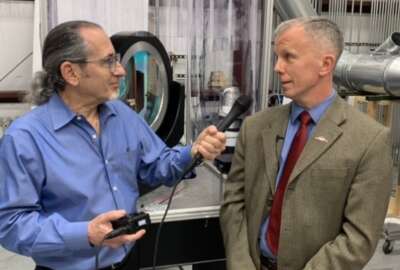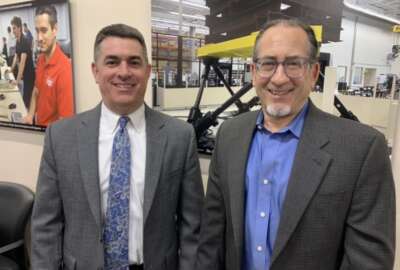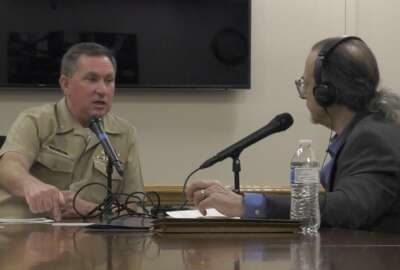On the gun line at Naval Surface Warfare Center, Dahlgren: Integrated engagement systems
When a weapon on the gun line of the Naval Surface Warfare Center Dahlgren Division fires, you hear a thud and seconds later see a splash out in the Potomac River.
Best listening experience is on Chrome, Firefox or Safari. Subscribe to Federal Drive’s daily audio interviews on Apple Podcasts or PodcastOne.
When a weapon on the gun line of the Naval Surface Warfare Center Dahlgren Division fires, you hear a thud and seconds later see a splash out in the Potomac River. It sounds and looks rough, but in fact each trigger-pull is the subject of detailed measurement and analysis. For the third installment of our series on Dahlgren, the Federal Drive with Tom Temin spoke with the division’s integrated engagement systems chief, Daniel Ross.
Interview transcript:
Jared Serbu: Tom Temin spoke with the divisions integrated engagement systems chief, Daniel Ross.
Daniel Ross: So Dahlgren, where the Navy Surface Warfare Center is, we are predominantly a research development and integration hub for the Navy. And so systems that are going to go aboard ship will typically come through Dahlgren for development and evaluation and integration to ensure that they’re going to be safe for shipboard use.
Tom Temin: So the pathway then is from Navy requirement, to contractor prototype, to Dahlgren?
Daniel Ross: That is one of the typical avenues that we see systems come through, we also do in-house development here, which I think makes us pretty unique in that we have folks here developing systems, they can contact us get out on the range pretty quickly evaluate how their system is performing, and then go right back to the lab continuing to evolve that design, and mature it and then come right back out, test out to see how they’re doing. So it’s kind of that incremental evaluation of system design. And having us located right here on the river, be able to simulate that lateral environment over the water puts us in a pretty good position to evaluate systems as they would be operationally.
Tom Temin: And what are the different variables? What are the major ones that would be affecting a new system before it’s put on a ship?
Daniel Ross: Well, that’s a broad question, right? Because if you think about all the different systems that go, but we’re looking at anything from how a projectile performs in flight to how an electronics cabinet aboard a ship might perform under typical shock and vibration phenomena that it may see in the fleet. So it’s truly a broad capability that we have here to evaluate systems.
Tom Temin: And at the end of the day, even though it’s highly data intensive, there is no substitute for firing shells like we’re hearing in the background today.
Daniel Ross: That’s right, you got to see, us firing some systems today, that live component will always be there. One of the things that we are focusing on, though right now is integrating some of our digital capability into our test events. Because we feel like that gives us a better end to end operational assessment of how a system performs. So we’re tying into some of the other labs that we have. And that’s part of the reinvention effort as well.
Tom Temin: Because Dahlgren is also looking at the general issue of digital engineering, where you do a lot of prototyping and testing before you move to physical structure.
Daniel Ross: Right.
Tom Temin: Can that apply to gun performance?
Daniel Ross: It can, you know, we build models for the systems that we put aboard a ship. And so those models help us predict how systems might perform in operational conditions. And then, you know, as that design matures, and the model matures, you know, we can get a better idea of how something will perform before we go out and qualify it as part of a live test.
Tom Temin: And there’s no analog in the private sector to a naval gun, the sea one and you know exactly what you’re looking for, as much as people would like to have one on their SUV. They’re only in the Navy. And so what is out there available, that from the commercial world that can be used to test and evaluate these systems, versus what you need to develop because of how unique they are.
Daniel Ross: Well, we partner with industry a good bit, our chief technologist is working to form some new partnerships now as we speak, to leverage some of that capability that comes from industry. So we’re working to stand up a lot of those new relationships right now. And with academia as well, they can provide quite great capability to help us evaluate some of these systems.
Tom Temin: So would a case in point, the, say, recoil measurements, that’s pretty much a unique measurement to the military.
Daniel Ross: Sure.
Tom Temin: But you also have a brand new vibration lab, which could be applicable to many, many systems in the commercial domain. So maybe talk about vibration for a minute, and what the new capability there is.
Daniel Ross: Sure. So we have several folks that are working on cutting edge technology that will allow us to simulate pretty much any transportation environment that a system might see in the fleet. So you think about all the potential platforms that a piece of military gear can be transported on having the ability to replay those environments in our labs. So we’ll go out we’ll measure those environments, we have the right folks in-house here to translate that into something we can play on our vibration equipment. And so what that buys you is an early look at how some of these new pieces of gear are going to perform in similar environments that they’d see in the fleet. And so we can provide that information back to the designer, buy them some margin by providing real world environments, and kind of go through that whole iterative process, again, where we design, test and fix.
Tom Temin: Because I guess for practical purposes, if you have an electronic module of some size, a rack or something, if it’s mounted on a freight train, it’s probably going to be similar to what it might encounter on a ship over time.
Daniel Ross: Sure, it could be and you know, understanding those nuances is really important. And so again, I go back to the people that we have in-house here that can go out and measure those environments, make sense of them, bring it back to our labs, and then play them again so that you know exactly how you’re going to perform on the railway or on that ship.
Tom Temin: And getting back to the general issue of testing guns before they’re delivered to the Navy. How often does a given millimeter or given system on a ship get replaced?
Daniel Ross: There are constant evaluations underway to take a look at new technologies and what we might be able to bring to bear in the fleet. We talked a little bit earlier about some of the larger calibers, you know, 16 inch guns that we used to have out in the fleet years ago. And now we’ve evolved to using you know, smaller caliber more accurate projectiles, directed energy you probably hear a lot about, but all these new technologies are coming to bear in the fleet, and a lot of them are coming through Dahlgren for evaluation.
Tom Temin: And do you also have the capability of testing the ordinance itself? Does it explode the way it should? And how do you test for example, lethality, because that, unfortunately, is what the purpose of it is.
Daniel Ross: Sure, we have a great capability here we have two explicitly cited ranges just to your across the creek, where we take a developmental projectile or ordinance item, we will detonate that in its design mode and evaluate how it breaks up. And so we take that data and analyze that to understand how it’s performing, and whether or not it will do the job once it gets to a target. So we do various types of explosive testing over what we call Pumpkin, that’s our explosive experimental area here.
Tom Temin: Because for a navy shell the purpose is not like a bullet in a rifle or something. The purpose is to wreck another ship often so you can figure out how that’s likely to happen or if it’s likely to happen with a given system?
Daniel Ross: Sure we can we have lethality models that once we get our physical data from these tests, we can feed those into the lethality models and get an understanding of how that projectile or that item would actually perform if it were fired in the fleet.
Tom Temin: And I’ve noticed a lot of people here have long tenure.
Daniel Ross: That’s right.
Tom Temin: And given the competitiveness of the technology we’re seeing these days. What keeps people here, do you think?
Daniel Ross: I think there’s something to be said about the work that we do here. We say often around here that the sound of gun firing is the sound of freedom. I truly believe that this place scratches the patriotic itch that many of us have. And so I don’t think you can go anywhere else in the country and do this type of work. It’s rewarding to see items that you have evaluated or worked on to design, get to the fleet and be used safely by our sailors. It’s a very rewarding experience and I’m proud to be able to work here.
Copyright © 2024 Federal News Network. All rights reserved. This website is not intended for users located within the European Economic Area.
Tom Temin is host of the Federal Drive and has been providing insight on federal technology and management issues for more than 30 years.
Follow @tteminWFED






